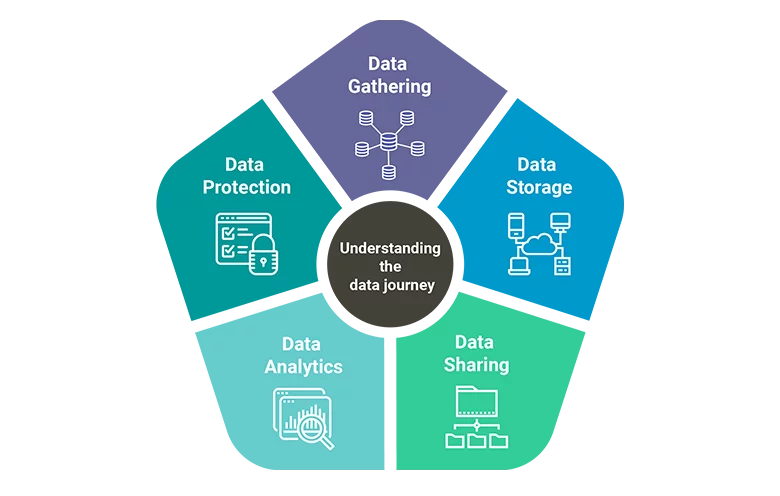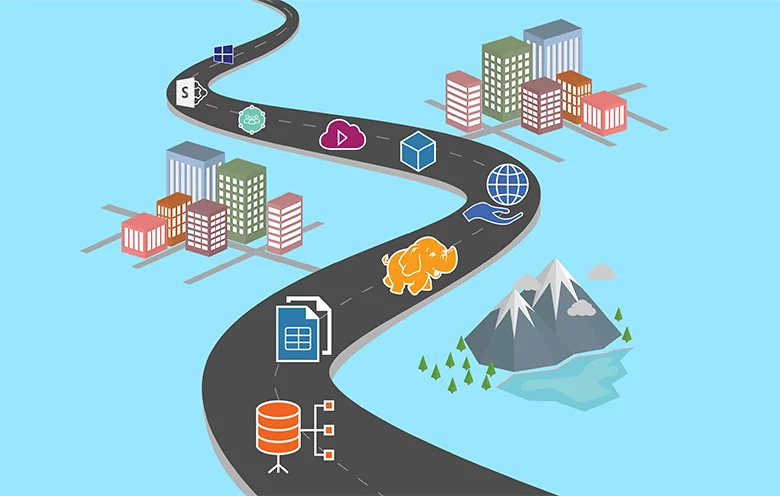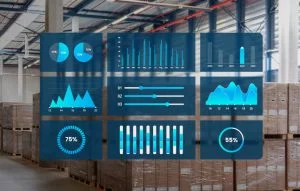Data is the most valuable resource that organizations have at their disposal today. It is being created at a speed faster than ever before and in all forms that one can possibly imagine. Data consulting services provide a way to collect data from various sources, structured and unstructured, generated either by humans or machines, to discover an entirely new world of business opportunities. While some companies have excelled in collecting, storing and analyzing data, a larger percentage lag behind at consolidating and using their data to get real insights.
Here are some of the most common issues companies are facing related to data-
- Unable to capture unstructured data
- Unable to keep all the historical data
- Inability to prioritize data assets
- High risk of exposure of the data
- Uncertainty while choosing data tools
Understanding the data journey
To resolve these data related issues, it is important to understand the journey of data within your organization. Data passes through several stages right from collection to storage, processing, analytics, and deletion. Following a consistent and structured approach throughout is very much required. There are also requirements under GDPR and other data laws, which must be met at every stage to ensure that data is in full compliance with regulations. The way companies collect, store and analyze data can make or break their business.
Harley-Davidson used artificial intelligence to increase their New York sales leads by 2,930%
-Harvard Business Review
This is where data consulting companies can help you to assess your current data architecture and identify the shortcomings. With proper data acquisition, data transformation, and data access, companies can carve out new data architecture for their business. Let us explore the various stages of data journey in detail:

1. Data Gathering
When collecting data, organizations must focus on the data requirements they have, so as to not waste time collecting data that is not needed. Also, keep in mind that the data you are collecting is accurate, complete, reliable, relevant, consistent and unique. You can collect data from various sources like transaction history, enquires, complaints, surveys, social media, website activity, referrals and more. By having data from diverse sources, you can have better chances of finding more actionable insights.
It is good to limit yourself from collecting data that is necessary and keeping your customers informed regarding the intended purpose of collection. The way companies collect data is now strictly monitored by data regulation agencies and any data violation can result in legal issues.
2. Data Storage
You can store the data after collecting it. Developing a storage strategy for your business is an important part of the overall data journey. The storage solution should be in accordance with your specific business needs, allowing you to access data quickly whenever required. Though the cloud is the most preferred storage option for businesses nowadays, still the best storage solution is the one that involves a mix of both on-premises and cloud storage.
Here are a few other things you must keep in mind while storing data:
- Combine different data types to create a unified customer profile
- Integrate structured and unstructured data sources
- Clean up your data and remove useless information periodically
- Ensure that the critical data is backed up regularly
3. Data Sharing
When data is to be shared with third parties to accomplish business goals, your organization must take proactive measures to ensure that personal data is processed in a way that ensures security. You must carry out a background check to know the track record of these third parties so that you can select the ones which can handle your company’s data efficiently. It is also important to capture permissions from your users regarding data sharing. You must provide details to your customers about these third parties, and for what purpose and duration the data will be shared.
4. Data Analytics
After you have collected and stored your data efficiently, it is time to start analyzing it. There are several ways to analyze your data, which includes data mining, data visualization and much more. During this stage of the journey, data is manipulated in a number of ways to find common patterns, latest trends, and distinct characteristics based on which new business strategies can be formulated. These new insights can help organizations to reduce operational costs, improve profit margins, build consumer trust, and find new opportunities to make money.
Data analysis is the most labor-intensive part of the entire data journey. Your organization should try to automate these processes within your organization. There are a number of data analysis tools available in the market which can help you achieve automation.
5. Data Protection
Though there are no issues in collecting data after getting consent from customers and using it, the problem arises when this sensitive data is lost or misused, exposing consumers to harm. The recent Marriott guest data breach where personal data of around 500 million users was hacked included details like name, mailing address, phone number, passport, credit card details and more. These kinds of data breaches are on the rise and therefore organizations must work diligently towards data protection. They must understand their responsibility towards protecting data and secure it using the latest tools and technologies.
Here are some of the data protection practices to follow:
- Choose a cloud service provider that has strong security features
- Save data in multiple clouds and use one or more as backup
- Encrypt data before uploading to cloud or storing it on-premises
- Keep yourself updated with current data protection regulations
- Delete the data when you no longer need it
Final say
Through this data journey, companies get a chance to contemplate and re-assess their current data practices. They can work towards discovering their information assets and framing policies to maintain and manage data securely. By paying attention to every little detail of the data journey, businesses can approach data with efficiency in mind. If you need assistance regarding improving any stage of this journey, you can contact our data experts.









